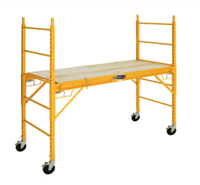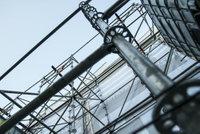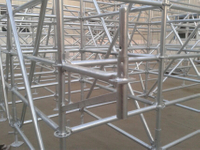Content Menu
● What Is Cuplock Scaffolding?
● Why Consider Buying Second Hand Cuplock Scaffolding?
● Critical Checks Before Buying Second Hand Cuplock Scaffolding
>> 1. Visual Inspection of Components
>> 2. Check for Corrosion and Rust
>> 3. Verify Dimensions and Compatibility
>> 4. Confirm Compliance with Safety Standards
>> 5. Assess History and Usage
● Detailed Inspection Checklist for Second Hand Cuplock Scaffolding
● Common Defects and Issues in Second Hand Cuplock Scaffolding
● Safety and Regulatory Considerations
● Tips for Buying Second Hand Cuplock Scaffolding
● Conclusion
● FAQ
>> 1. Is second hand cuplock scaffolding safe to use?
>> 2. What are the key defects to look for in second hand cuplock scaffolding?
>> 3. How often should second hand scaffolding be inspected?
>> 4. Can I mix cuplock scaffolding components from different manufacturers?
>> 5. Where can I find reliable second hand cuplock scaffolding for sale?
Purchasing second hand cuplock scaffolding for sale can be a cost-effective solution for contractors and builders looking to save on equipment costs without compromising safety and quality. However, buying used scaffolding requires careful inspection and knowledge of key specifications to ensure the equipment is safe, compliant, and suitable for your project needs.
This comprehensive guide covers everything you need to know before buying second hand cuplock scaffolding, including inspection checklists, common defects to watch for, safety standards, and tips for sourcing reliable suppliers.

What Is Cuplock Scaffolding?
Cuplock scaffolding is a modular steel scaffolding system characterized by its unique node-point locking device. Vertical standards have fixed lower cups welded at 0.5 m intervals and sliding upper cups that lock horizontal ledgers and braces securely in place with a simple twist or hammer blow. This system allows up to four horizontal members to connect at one node, enabling rapid and versatile assembly.
Why Consider Buying Second Hand Cuplock Scaffolding?
- Cost Savings: Used scaffolding can be significantly cheaper than new, reducing upfront investment.
- Availability: Often immediately available for urgent projects.
- Sustainability: Reusing scaffolding reduces waste and environmental impact.
- Proven Durability: Cuplock systems are robust and can last many years with proper maintenance.
Critical Checks Before Buying Second Hand Cuplock Scaffolding
1. Visual Inspection of Components
- Standards (Verticals): Check for dents, bends, cracks, or corrosion on the steel tube and welded cups. Cups must be firmly welded without cracks or distortion.
- Ledgers and Braces (Horizontals and Diagonals): Inspect for straightness, surface damage, and corrosion. Check that forged blades at ends are intact and not bent.
- Couplers and Locking Cups: Ensure sliding cups move freely but lock firmly, and that no parts are missing or damaged.
- Base Plates and Accessories: Verify base plates are flat and undamaged; check guardrails, toe boards, and ladders for wear.
2. Check for Corrosion and Rust
- Surface rust can be cleaned, but deep pitting or corrosion that compromises tube thickness is a safety risk.
- Hot-dip galvanized finishes are preferred for corrosion resistance; worn or flaking galvanization should be noted.
3. Verify Dimensions and Compatibility
- Confirm tube diameter (usually 48.3 mm) and cup spacing (0.5 m intervals).
- Ensure all components are from the same system or compatible brands to avoid assembly issues.
4. Confirm Compliance with Safety Standards
- Ask for documentation proving compliance with relevant standards such as EN 12810, EN 12811, or local regulations.
- Check that the scaffolding has been inspected regularly and maintained properly.
5. Assess History and Usage
- Inquire about previous usage, storage conditions, and any repairs or modifications.
- Avoid scaffolding with unknown or questionable provenance.
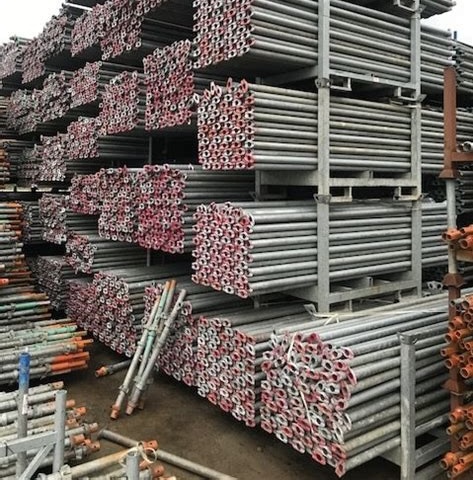
Detailed Inspection Checklist for Second Hand Cuplock Scaffolding
| Inspection Item | What to Look For | Acceptable Condition |
| Standards | Straightness, weld integrity, cup condition | No bends, cracks, or loose cups |
| Ledgers and Braces | Straight tubes, forged blade condition | No dents, bends, or worn blade ends |
| Locking Cups | Smooth sliding, secure locking | No deformation, missing parts, or excessive wear |
| Corrosion | Surface rust vs. deep pitting | Minor surface rust acceptable; deep corrosion not |
| Base Plates | Flatness, absence of cracks | Undamaged and flat |
| Guardrails and Toe Boards | Structural integrity, fastening points | Secure, no missing parts |
| Accessories (Ladders, Stairs) | Rung integrity, stability | No broken rungs or loose fittings |
Common Defects and Issues in Second Hand Cuplock Scaffolding
- Bent or Twisted Tubes: Compromise structural integrity and assembly ease.
- Worn or Loose Locking Cups: Reduce locking strength and increase risk of accidental disengagement.
- Corrosion and Rust: Especially at weld points and tube ends, can weaken components.
- Missing Components: Such as base plates, guardrails, or locking pins.
- Improper Repairs: Weld repairs or modifications that do not meet standards.
Safety and Regulatory Considerations
- All scaffolding, including second hand cuplock scaffolding, must comply with local safety regulations.
- Regular inspections by competent persons are mandatory before use and at intervals no longer than 7 days.
- Scaffolding must be erected, altered, and dismantled by trained personnel following manufacturer instructions.
- Documentation of inspections and maintenance should accompany second hand purchases where possible.
Tips for Buying Second Hand Cuplock Scaffolding
- Buy from Reputable Suppliers: Choose vendors with good reviews and transparent histories.
- Request Inspection Reports: Prior inspection reports increase confidence in condition.
- Visit in Person: If possible, inspect the scaffolding physically before purchase.
- Negotiate Warranty or Return Options: Even used equipment may come with limited guarantees.
- Consider Transportation and Storage: Ensure you have the means to safely transport and store scaffolding components.
Conclusion
Buying second hand cuplock scaffolding for sale can be a smart investment if you carefully inspect the equipment, verify compliance with safety standards, and source from trustworthy suppliers. Properly maintained used scaffolding offers significant cost savings without sacrificing safety or performance.
Always prioritize thorough inspection of standards, ledgers, locking cups, and accessories. Avoid components with visible damage or corrosion that compromises structural integrity. With the right knowledge and precautions, second hand cuplock scaffolding can serve your project reliably and safely.
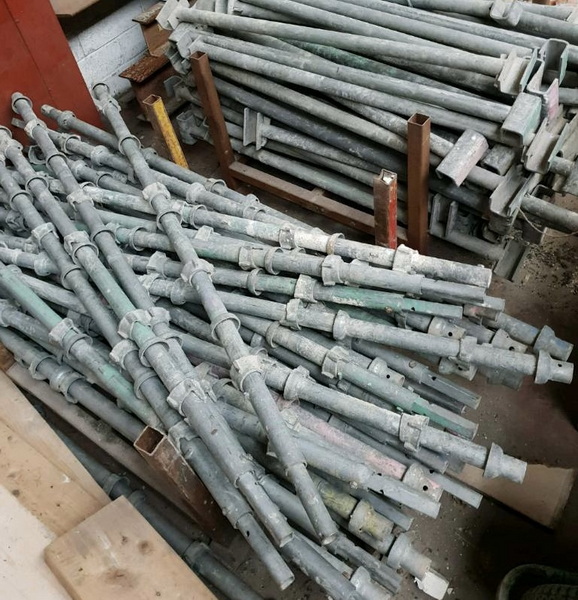
FAQ
1. Is second hand cuplock scaffolding safe to use?
Yes, if it has been thoroughly inspected, maintained, and complies with safety standards. Always ensure components are free from major defects.
2. What are the key defects to look for in second hand cuplock scaffolding?
Bent tubes, loose or damaged locking cups, corrosion, missing parts, and improper repairs are major concerns.
3. How often should second hand scaffolding be inspected?
Before first use, weekly during use, and after any event that could affect stability (e.g., storms, impacts).
4. Can I mix cuplock scaffolding components from different manufacturers?
Only if they are certified compatible and meet the same specifications. Otherwise, mixing can cause unsafe connections.
5. Where can I find reliable second hand cuplock scaffolding for sale?
Reputable suppliers, specialized scaffolding dealers, and verified online marketplaces with inspection reports and warranties.













